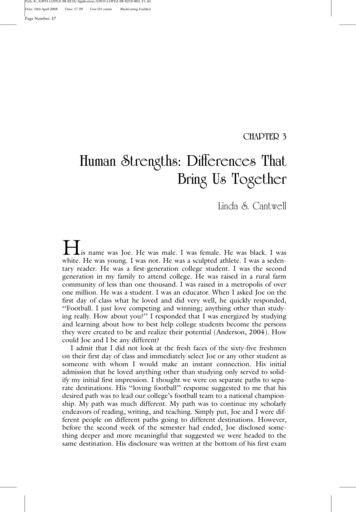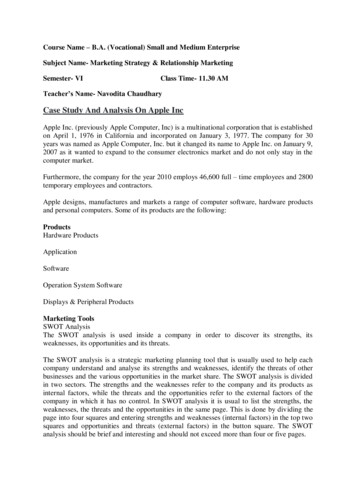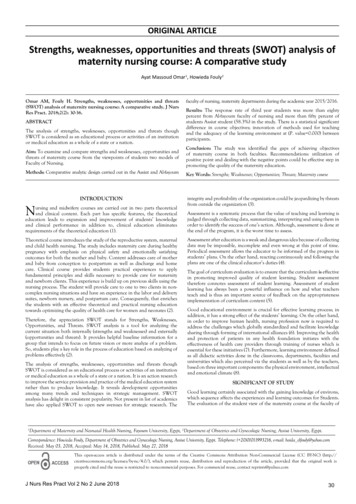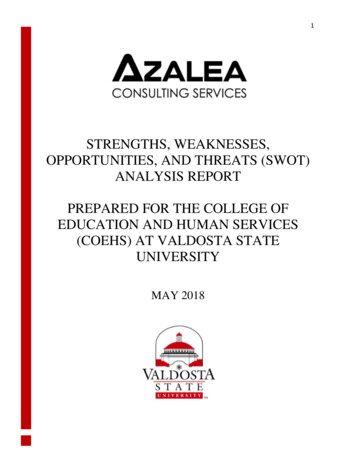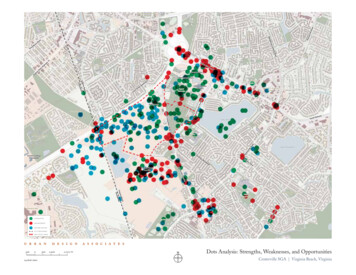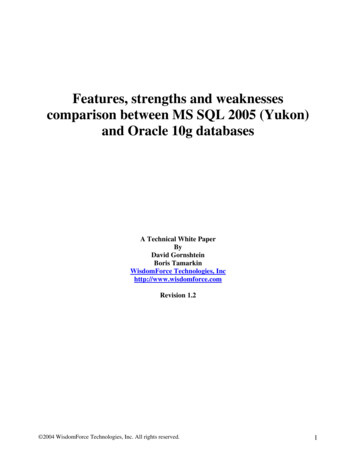
Transcription
Features, strengths and weaknessescomparison between MS SQL 2005 (Yukon)and Oracle 10g databasesA Technical White PaperByDavid GornshteinBoris TamarkinWisdomForce Technologies, Inchttp://www.wisdomforce.comRevision 1.2 2004 WisdomForce Technologies, Inc. All rights reserved.1
Note*: The latest copy of the document is available SSQL2005 ORACLE10g compare.pdfThis topic contains alternative comparison between latest versions of Oracle 10g and Microsoft SQLServer 2005 databases.Table of ContentsPreface. 4Major limitations of MSSQL prior to Yukon (such as MSSQL 2000). 5Locking strategy. 5Online space reorganization and table/index partitioning . 6Statistics . 7Clustering and high availability . 7Administration . 9Locking . 10Online data reorganization. 13Partitioning. 14Indexes . 15Clustering. 16Tuning . 17Function based indexes via indexed computed column. 17MSSQL 2005 Indexed View vs. Oracle Materialized Views . 17See our future whitepapers for MSSQL 2005 vs. Oracle 10g dynamic performance viewscomparison.Data export/import . 17Data export/import . 18WisdomForce FastReader. 18Replication . 19Peer-to-Peer Transactional Replication . 19Database Mirroring (Extend log shipping, automatic failover to a standby server). 19Backup and Recovery . 20Attach/restore database . 20Hot Backup . 21Fast Recovery. 21RMAN with Legato and Oracle Job Scheduler vs. MSSQL maintenance plans. 22Application features . 23Exception Handling . 23Online Analytical Functions topic . 23Queuing. 23XML Support . 24Asynchronous array of processed statements . 24.NET in MSSQL vs. Java in Oracle. 24Useful Oracle features that will have no compatible features in MSSQL 2005 . 25Oracle Logminer . 25 2004 WisdomForce Technologies, Inc. All rights reserved.2
Flashback Query . 25Auditing . 25Statistics History . 25Rollback statistics . 26Automatic Workload Repository . 26Object Oriented Features such as objects and vararrays. 26Optional compilation of PL/SQL to native binary (shared library) via C compiler . 27Useful MSSQL features that have no similar features in Oracle 10g. 28Identity . 28Notification services . 28Reporting Services . 28Replication . 28 2004 WisdomForce Technologies, Inc. All rights reserved.3
PrefaceThe purpose of the following white paper is to provide a feature comparison between MSSQL20051 and Oracle 10g. We will compare VLDB/OLTP related features and discuss issues withperformance, utilities and replication. We will discuss several new features, which were developedby Microsoft in order to provide competitive functionality to its commercial rival Oracle database.At the same time we will discuss the changes from a Database Administrator stand point that weredone to MSSQL 2005 release compared to previous releases. Since this topic is intended mostly toDatabase Administrators, we will not add information such as minimum requirements, supportedplatforms and max number of columns per table as redundant. We have never seen anyonepurchase a database product only because it can hold up to 32k columns per table and not "just"1024.Microsoft published "Top 10 Features for Database Administration" (actually all of them are verynice features). Nearly all of these features are present in Oracle since early 8i or prior. The"Snapshot Isolation" is only a kind of superset feature that provides midway functionality to Oraclerow versioning although with such cons as higher overhead. However MSSQL database was andstill is several steps ahead of Oracle in such great features like the ease of installation,configuration, performing basic tuning and the use of development tools.When comparing Oracle 8i/9i with MSSQL 2000 for VLDB/OLTP and enterprise applications onhigh end machines, the important limitation of Oracle always was the need for a highly skillfulOracle DBA, while almost every experienced MSSQL developer can perform DBA rolesuccessfully.Early conclusion: MS SQL Server made important progress with its new Yukon release. Howeverif you have a complicated application or systems running on high end machines you may still wantto consider using Oracle. For department level servers and small/mid range applications theMSSQL server would be a preferred choice.1MSSQL 2005 features based on publicly available beta 2 2004 WisdomForce Technologies, Inc. All rights reserved.4
Major limitations of MSSQL prior to Yukon (such as MSSQL 2000)Locking strategyThe main problem of the MSSQL 2000 compared with Oracle 8i/9i for VLDB/OLTP andenterprise applications on the high-end machines was the well-known MSSQL locking strategy.This locking would cause a high lock contention with a very high possibility of deadlocks in thecorrect transactional flows, which could work well on any databases that provide row versioning. Inaddition, MSSQL 2000 lock escalation mechanism caused locks to be escalated to the block oreven table level in case of high concurrency, which is very common on high end, SMP machines. 2Here the impact of this locking strategy from the author’s DBA practices:It was late 2001, when one of our customers had MSSQL 2000 EE installed on an IBM server with2 CPUs. That customer had an additional backup server of the same configuration. The largest tablein the system (large ISP radius server with widely used AAA e.g. authentication, authorization, andaccounting) was the accounting history table. This table contained information ofconnects/disconnects made to the ISP by its customers. The table has grown and became about midsize table (from the Oracle point of view) about 100GB. However the system was based onMSSQL 2000 and not Oracle. As you may know a 100GB table with concurrent inserts is prettylarge for an MSSQL database. The customer intended to upgrade their main server to 4 CPUsmachine. They switched to a backup server with an empty accounting table and have run it withthis configuration for about 2 days. At that time the table already had about 750K rows. Customerthen tried to copy those 750K rows to the main table with about 60x10 6 rows (100GB) by usingDTS. We performed the test of copying 750K rows via DTS to an empty table, which took about 12minutes, and then we copied this data to the real, large table. The copying process itself took thesame 12 minutes, but immediately after copy MSSQL started to rebalance the 20GB index on thistable and this fact halted the upgraded server with 4 XEON CPUs for 5 hours.2Even in MSSQL server 7 and/or 2000 you can disable lock escalations by using the undocumented (forthese versions) trace flags 1211 or 1224, where 1211 will completely disable lock escalations and 1224 willdisable lock escalations until lock structures will consume more then 40% of memory used by MSSQL inthe low 2GB (e.g. excluding AWE memory in case of Windows 2000 advanced). To turn on one of theseflags (for example 1211) in a single session, run DBCC TRACEON (1211, -1). To do this permanently, onthe server level go to the windows service manager, MSSQL service, and add -t1211.For example, the service definition may look like:%SQL SERVER HOME%\mssql\binn\sqlservr.exe -t1211If both trace flags 1211 and 1224 are turned on, 1224 takes precedence over 1211.For more details, see http://support.microsoft.com/default.aspx?scid kb;en-us;323630&sd tech 2004 WisdomForce Technologies, Inc. All rights reserved.5
The table had no clustered indexes, e.g. it had heap instead of B-Tree organized table3.Best guess of what did happen, is that due to a large number of inserts, SQL server escalated thelock to exclusive table level lock.*Note: Here we are coming to an additional MSSQL 2000 problem that seems to be solved in theMSSQL 2005: Dedicated Administrator Connection which will be described with more details inthis document in Administration.Online space reorganization and table/index partitioningStarting from version 8.1.x and until the current 10g, Oracle has been constantly increasing thenumber of DDL operations that can be performed online. In Oracle 10g you can rebuild and movean index or even a table without the need to hold an exclusive lock for the duration of the rebuild.However a momentary lock is required to complete the operation. During the rebuild the table isfully operational and can be updated, new indexes can be built and so on. Oracle 9.2 until 9.2.0.5patch set experienced a number of bugs related to online index and table reorganizations, especiallyin the RAC environments but it seems that from 9.2.0.5 and 10.1.0.3 most of these issues have beenresolved.In MSSQL 2000 the only online partial index compact / reorganization has been available byDBCC INDEXDEFRAG, however this operation skipped blocks which could not be exclusivelylocked. MSSQL 2005 has several additional online reorganization options, which will be explainedin more details and compared with options available in Oracle 10g in online data reorganization.3Now we will try to explain this:1.Select from the table without a clustered index, does not returns the rows in the same order, as they have beeninserted. The order of inserts has the following effect on a non parallel select:a.Non-parallel select will return sorted sequences of values and in most case these sequences will be dense.For instance, table filled with rows having key values of 1 to 100000000, the select (without order by clause) couldreturn the following sequence of keys:1, 200, 212, 320, , 440, 441, 446, 2, 53, 78, 719, 729, 4, 9, 10, 15, 28, 35. After say 30000 all (or almost all) ofthe sequences will be dense, e.g. 40000, 40001, 40002, 40003 42000, ,30000, 30001, 30002, 30003 32000,( Continued on next page footnote )*Note: Such behavior is not documented but our tests show that MSSQL 2000 works this way.b.Sorting these sequences by, for instance, quick sort and merge to the single, dense, sorted sequence or to buildB Tree index from it, is much cheaper (in CPU cycle) than building such index from randomly distributed data.c.Most of these sequences will be dense. Per our understanding of this issue, select scans blocks according toIAM index for specific table (without clustered index) begins from the First IAM block. Then the non dense sequencesappear after each 8 blocks extents filled up and new block in empty or mixed extent allocated. In addition, according toour tests, if the table is smaller than a single extent (e.g. 8 blocks in size), it will be scanned by the select in the order ofinsertion.2.Let’s consider two wide tables that were built with 30 columns each. Both tables contain several variablelength columns such that row length is more then 1000 bytes. The first table will have a clustered index. The secondtable will not have clustered index, but instead will contain a three columns regular, unique index. Filling the first tablewith a clustered index with 10 million rows will take significantly longer than filling the second one.Rows to the table have been inserted in a chronological order and up to this moment we have never deleted historicalrecords. 2004 WisdomForce Technologies, Inc. All rights reserved.6
StatisticsMSSQL 2000 had far less time-based numeric statistics than comparable v views in Oracle.In MSSQL 2000 (and in 2005 as well) there is just a small amount of tuning related, time basedstatistics. However MSSQL exports rich set of online statistics by using Windows Performancemonitor, which is very visually appealing. The only problem is that taken constantly, the statisticsconsume huge amount of disk space. These statistics are very useful and nearly equivalent to theOracle 10g OEM provided statistics.A very small number cumulative statistics is available in MSSQL database since "instance startup"or another "point in time” by using DBCC PSS, DBCC PROCCACHE, DBCC OPENTRAN andseveral online statistics via system stored procedures such as sp whp, sp lock and so on.In addition, starting from MSSQL 7, Microsoft provides MSSQL Profiler and Server-Side Trace,which provide functionality similar to Oracle event 10046 or sql trace one. MSSQL 2005 extendsthese capabilities with Oracle-style dynamic performance views. The default user “dbo” now ownsall the tables in the database master, which previously began with sys. In MSSQL 2005master.dbo.sysdatabases became a dynamic view belonging to the user “sys”:master.sys.sysdatabases. (What does this remind you of? ) . For the details on features comparisonsee further in this document the tuning.Clustering and high availabilityStarting from late versions in MSSQL 6.5 and 7 Microsoft provides a fast failover clusterconfiguration. This is equivalent to the DataGuard cold failover in Oracle. However the fastfailover in MSSQL is pretty rapid even compared to Oracle 9i RAC Transparent ApplicationFailover, which is advertised as a superior high-availability solution as compared to DataGuard.This is due to the fact that all RAC nodes experience “Reconfiguration” on node failure on top of,for example, Sun Cluster 3.1 halt of at least 10 - 30 seconds. The exact time of “Reconfiguration”depends on the amount of locks present in the failed node and overall transaction load. At the sametime a well-configured MSSQL 2000 on top of a Microsoft Cluster will failover to the other serverwithin about 15 seconds.However, neither MSSQL 2000 nor MSSQL 2005 provides a shared disk cluster based scalabilitysolution similar to the concept of the Oracle 10g data grid.Oracle 10g “data grid” in reality is nothing more than just another buzz used mostly in the business,since Oracle 10g supports grids of 4 to 8 instances on most platforms. In addition, most of today’sstorage vendors do not understand exactly, what the term "storage grid" means. However the ideaitself looks promising. We should keep in mind that it will take a long time for MSSQL 2005 tobecome a stable release. Perhaps Oracle will have working grids at that time as well.MSSQL database uses another term for "shared nothing cluster". The idea is to have several serversand MANUALLY divide the data between these servers. In other words, perform MANUALhorizontal partitioning of all tables. At same time there is a need to create a special type ofpartitioned views where each view is a union of tables identified by linked server definitions in thestyle of server name.database name.owner name.table name. For instance, it can behistory server 1999.sells.dbo.order lines, where table order lines, which resides on server linkedas "history server 1999" has constraint on a partitioning column. The constraint ranges of all thetables involved in the union view must not overlap. 2004 WisdomForce Technologies, Inc. All rights reserved.7
All this might sounds good, but it is not as good as Oracle shared disk cluster configuration. Inorder to scale out Oracle RAC, you need just to install Oracle software on another machine, createseveral configuration files, and add redo logs to the thread. Then you can startup additionalinstances without performing a single change to the application’s database schema. Only severalinstance level changes are necessary such as the addition of an undo tablespace and redo log groupsto every new instance. However, these changes do not require shutdown of the working database.Now let’s discuss the case when you need to scale out the system on MSSQL. MSSQL with itsshare nothing architecture, requires, after adding a new sever, the creation of additional tables foreach cluster partitioned view you have, move part of the data, rebuild all existing tables and views.Such an operation requires a significant maintenance effort and cannot be called “add node ondemand easily" while in Oracle 10g RAC such operation can be done within the minutes. Inaddition, Oracle RAC in versions prior to 10g (7/8/8i OPS and 9i RAC) has been running on top ofOS specific cluster solution such as Veritas cluster, HP MC Service Guard, Sun Cluster etc.(although from OPS 8i Oracle has it’s own cluster services for Windows e.g. OSD cluster softwareand from RAC 9i also on Linux) this required additional installation, licenses and additionalexpenses. The new Oracle 10g comes with a built in cluster solution, called “Cluster ReadyServices (CRS)”.In addition to free proprietary clusterware, Oracle 10g provides an automatic storage managementsolution, called “Automatic Storage Management (ASM)”. ASM is supposed to simplify 10g RACstorage management as compared to raw devices. Be aware though that all these features are yetquite unstable. Even the current release is called “release version with several patch sets”, e.g.current is 10.1.0.3. We should add here a real life account.Several Oracle DBAs in one large billing solution provider tried to install 10g Cluster ReadyServices on HPUX 11i. There is no documentation about existing issues. Even Oracle support wasnot able to find the support engineer or BDE (Oracle Support Engineer having directly connectionto development unit) who has a good understanding of Oracle clusterware, since this subject iscloser to system management rather then to the database. Even Oracle RAC PAC team, which hasalways been the best source for RAC related problems solution, had expertise mostly in Linuxbased CRS.So, those DBAs realized that in order to install 10g RAC on HPUX they need MC Service Guardwith HP Serviceguard Extension for RAC exactly as they need it when install Oracle 9i RAC. Thisis despite of Oracle marketing information that Oracle brings proprietary clusterware for 10g RAC.The guys installed MC Service Guard, HP Serviceguard Extension, Oracle 10g CRS on HPUX,installed Oracle, ran several tests and everything was fine. When the tests completed, they wantedto simply uninstall CRS from HPUX servers. And here problems started. There is a guide on howto install CRS (and all this installation is under root account) but there is not even a singledocument on how to uninstall the CRS and there are several processes running under root account.The system administrators decided to "kill -9" all these process, remove CRS from all the initscripts hopped to end it there. However after they did "kill -9" both servers restarted and restartedand restarted forever . until HPUX OS has been reinstalled.So, although 10g grid idea is much better than a specific MSSQL share nothing clusterimplementation, it is still far from being simple in installation and use.The idea of a share nothing cluster itself has several pros and cons over other shared disk clusters,but describing this would require an additional topic. 2004 WisdomForce Technologies, Inc. All rights reserved.8
By the way, a share nothing cluster could be implemented more efficiently than it was done in SQLServer. For instance, consider IBM EEE DBi2 v8 share nothing cluster. IBM allows easily creatinga DB2 instance on additional computer, creating a partition and defining its configuration, addingpartition on additional computer and using a single command "redistribute nodegroup GLOBALuniform" you will redistribute all the tables. Just be sure, that the partitioning key (unique or not) isdefined on all the tables in that node group.AdministrationMSSQL 2005 administration is as simple as every Microsoft product administration with a niceGUI and only a few parameters required a manual change.In addition, in the case of the not so uncommon SQL server halt (it is much more common that allWindows would halt together with SQL server) the special Dedicated Administrator Connectionhas been added.MSSQLa) Dedicated Administrator Connection isallowed only from SQLCMD command lineutility for these MSSQL server DBAs that neverused command line.The expected syntax is:Oraclea) sqlplus "/ as sysdba"connected OS user will become a member ofdba group.SQLCMD -S davidg01\COMP01 -U system -Pmanager –Awhere system is any user having sysadminfixed server role (my test user) and manager ispassword davidg01\COMP01 SQL serverinstance –A means this is DedicatedAdministrator Connection.Unfortunately, this option does not really worksin MSSQL 2005 beta 2b) Additional administration related feature is toallow enforcing policies for SQL Server loginpasswords and allowing for the separation ofowners and schemas.Unfortunately, this option does not reallyimplemented in MSSQL 2005 beta 2b) Oracle provides password complexityenforcement rule started from version 7. This isimplemented in function sys.verify function,where dem function defined in file ORACLE HOME/rdbms/admin/utlpwdmg.sqlStarting from version 8i, Oracle provides anoption to connect with some user and thenchange the schema to different user. Forinstance, if you connected with user "scott", butwant to work in schema "apps". It is possible to 2004 WisdomForce Technologies, Inc. All rights reserved.9
do by executing" ALTER SESSION SET CURRENT SCHEMA apps;"LockingThe most notable feature added in MSSQL 2005 is probably a new isolation level called SnapshotIsolation (SI). The idea has been to add row versioning option to MSSQL so that Updates will not block the select operation.If working in so called "Read committed snapshot" isolation level which is equivalent toSCN based consistent read mode, then all fetched rows will be returned in the same state asit just was on select statement execution.If working in so called "Snapshot Isolation (SI)" isolation level, then all fetched rows willbe returned in the same state as they were on transaction beginThe only reason to use (SI) mode is probably to provide an option to create a report that representsa consistent snapshot of complete system in point-in-time. (SI) mode has no direct equivalent modein Oracle. It can be simulated although by, for instance, Oracle Flashback Query mode that is aswitch to flashback mode in some point-in-time and create report using a consistent snapshot of thesystem.There are three general differences between Oracle and MSSQL in the row versioningimplementation:I. Oracle implemented the row versioning on the DB block level, while Microsoftimplemented it on the level of each single row. Microsoft claims that its ownimplementation is better and faster. However we did not see any evidence of this claimsince Oracle provides similar performance with block based row versioning on the samehardware and OS compared to MSSQL with no row versioning (please see the TPCC resultsbelow).II. Oracle uses undo segments to store undo records while Microsoft uses TempDB for thatsame purpose.III. Oracle metadata is managed in the same manner as table data. So during data querying mostof online DDL statements on the table (add or drop indexes, add partitions and evenreorganize space) can be performed simultaneously. The same is also correct in the case ofsessions when using some kind of Flashback Query. On the other hand, in SQL Server allDDL operations that are currently running on tables belong to database "SnapshotIsolation". "Snapshot Isolation" queries are prohibited.After we went through reading Microsoft TechNet note about SQL Server 2005 Beta 2 SnapshotIsolation, there is couple of things we want to mention.We are left very skeptical after looking at the terms of optimistic/pessimistic concurrency control.There are many reasons for working in non-blocking mode rather than blocking mode. While 2004 WisdomForce Technologies, Inc. All rights reserved.10
working in non-blocking mode, Oracle database’s performance is similar to MS SQL working inblocking mode when considered all aspects: of scalability, manageability, simplicity of design andcode.Several SQL Server whitepapers (for ol/sql/2005/SQL05B.mspx) mention that it isrecommended working using pessimistic locking mode in order to achieve better performance.However Oracle, which is always running with an optimistic locking mode, achieves the sameperformance on the same hardware as SQL Server with pessimistic locking mode. It looks like SQLServer just needs to optimize the code a little bit. For example, look at the following TPCC resultson Unisys ES7000 Aries 420 Enterprise Server.*Note: since Oracle database license is more expensive than SQL Server, the hardware used forthe MSSQL 2000 benchmark was somewhat better:Databasetpcc/m -----------------Oracle Database 10g EE291413 4.98 US Microsoft SQL 2000 EE309036 4.49 US From the results table above it is easy to see that MSSQL performed 6% better. However Oracleruns more efficiently on UNIX platform and not on Windows. Apparently, Oracle databaseprovides nearly the same performance as MSSQL, which uses pessimistic locking, while Oracleusing optimistic locking.In addition, the MSSQL Server whitepaper in some places compares MSSQL 2005 with some earlyversion of Oracle 8i or bellow. It is similar to comparing the latest StarOffice7 with MicrosoftWord 2.0. For instance, the white paper discusses manual rollback segments management.The table below analyzes the document “SQL Server 2005 Beta 2 Snapshot technol/sql/2005/SQL05B.mspx) published on July 13,2004. We found four facts that we have a different opinion on how authors of that document arecriticizing Oracle database in favor of MSSQL Server. Our opinion is based on expertis
comparison between MS SQL 2005 (Yukon) and Oracle 10g databases A Technical White Paper By David Gornshtein Boris Tamarkin WisdomForce Technologies, Inc . disable lock escalations until lock structures will consume more then 40% of memory used by MSSQL in the low 2GB (e.g. excluding AWE memory in case of Windows 2000 advanced). .

